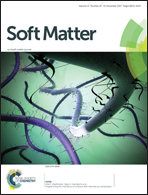Measurement of long range attractive forces between hydrophobic surfaces produced by vapor phase adsorption of palmitic acid†
Abstract
Extensive research into the surface forces between hydrophobic surfaces has produced experimentally measured interaction forces that vary widely in range and in magnitude. This variability is attributed to interference from surface nanobubbles and the nature of the hydrophobic surface. Whilst the effects of nanobubbles are now recognised and can be addressed, the precise nature of the surface remains a confounding factor in measurements between hydrophobic surfaces. Here we show that a monolayer coating with hydrophobic properties is formed by exposing metal oxide surfaces to palmitic acid vapour. Surface forces measured between these smooth hydrophobic surfaces exhibited an exponential attraction. Neither patchy surface charges, nor surface nanobubbles could explain the measured forces. However, the observed interaction may be explained by the interaction of a single patch of bilayered palmitic acid molecules interacting with an exposed patch of the hafnia surface. Such an interaction is consistent with the observed exponential nature of the attraction and the agreement between the measured decay of the exponential attraction with the Debye length of the solution.



 Please wait while we load your content...
Please wait while we load your content...